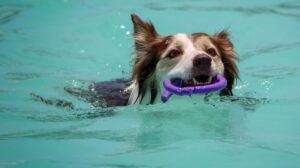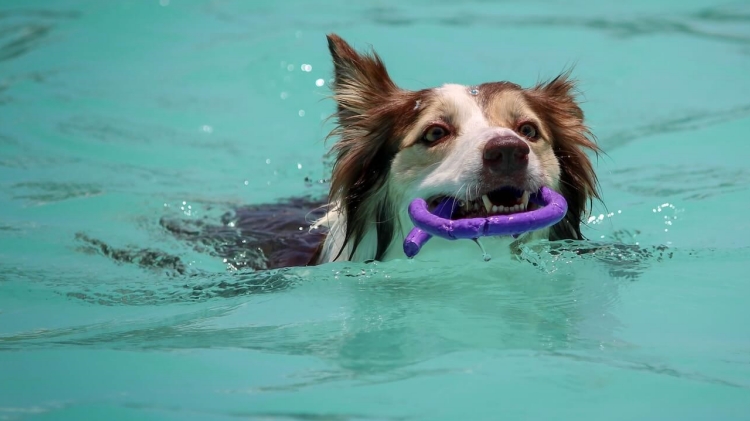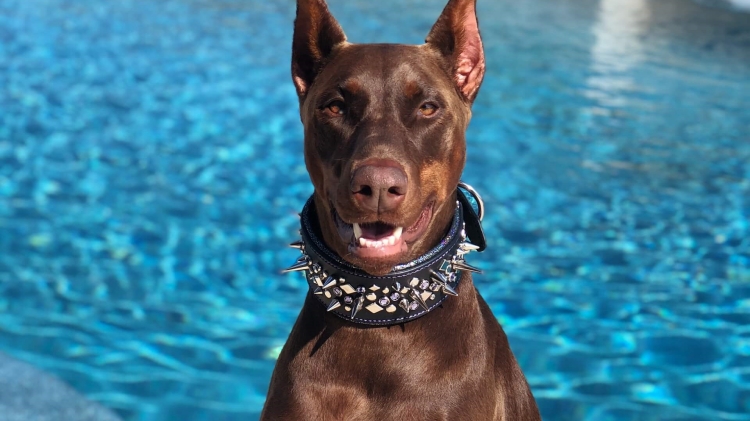
Fun in the Sun: Water Activities and Games for You and Your Dog
This blog is your go-to guide for making the most out of the sunny weather while bonding with your furry friend. The warmth of the

This blog is your ultimate guide to understanding how this fun and refreshing activity can significantly improve your furry friend’s overall well-being.
Just like humans, dogs can reap numerous health benefits from taking a plunge, and this blog post aims to shed light on the myriad of advantages that swimming offers to our canine companions.
Swimming is a low-impact exercise that is perfect for dogs of all ages and sizes. It is especially beneficial for older dogs or those with joint problems, as the buoyancy of the water reduces stress on their joints, allowing them to move freely without the pain and discomfort associated with other forms of exercise.
Moreover, swimming is a fantastic way to help your dog shed those extra pounds and maintain a healthy weight, which is crucial in preventing obesity-related health issues.
But the benefits of swimming for dogs don’t stop there. This activity is also an excellent way to improve cardiovascular health, increase muscle strength, and enhance overall fitness and endurance. Plus, it’s a great way to keep your dog cool and refreshed during the hot summer months.
So, whether your dog is a seasoned swimmer or has yet to dip its paws in the water, “Dive In! Exploring the Health Benefits of Swimming for Dogs” will provide you with all the information you need to make swimming a fun and healthy part of your pet’s life.
Let’s dive in and explore the wonderful world of dog swimming together!

Swimming provides dogs with excellent physical exercise that trains multiple parts of the body. Here’s an overview of the major physical benefits:
Swimming works a dog’s front and back legs as they paddle and kick through the water. This builds muscle strength and endurance, especially in the shoulders, upper back, and rear hips/thighs.
The resistance of the water against a dog’s torso engages the abdominal and back muscles to keep the body aligned, stretched long, and propelled forward. This tones the core.
A dog’s heart rate increases during swimming while their breathing controls oxygen intake. Over time, the heart grows stronger and more efficient at pumping blood and oxygen through the body.
Unlike running, the buoyancy of water reduces impact and weight on a dog’s joints. This makes swimming ideal for dogs with arthritis, hip or elbow dysplasia, and mobility issues.
Water allows dogs to move free of gravity’s effects on their body weight. This helps dogs with partial paralysis or neurological weakness strengthen muscles without having to bear their full weight.
The low-impact nature of swimming makes it a great exercise option during injury recovery. It allows dogs to rebuild muscle and stamina without taxing injured areas.
Paddling, kicking, and reaching forward to “grab” water engages a wider range of motion than basic running or walking. This enhances overall flexibility and limberness.
The resistance of the water gently pushes and stretches a dog’s muscles, connective tissues, and joints through a broader range of motion as they swim. This regular stretching keeps the body supple.
In addition to physical exercise, swimming also offers several cognitive and psychological benefits for dogs.
Having to coordinate paddling motions, control breathing, watch for obstacles, and more activates and challenges a dog’s brain. Mental stimulation helps tire out energetic, intelligent breeds.
Figuring out how to safely enter and exit a pool area, paddle efficiently, and more gives dogs an opportunity to problem-solve. Mental exercise tires dogs just like physical.
Dogs have to pay close attention to their surroundings when swimming and watch for other pets, pool edges, toys, and people. This high level of focus is mentally tiring.
The repetitive motion of swimming encourages a meditative, relaxed state of mind. Dogs release pent-up energy and anxiety through active swimming.
Dogs must control their breathing while swimming, promoting a focused, calm mental state. This provides stress relief.
Many dogs see swimming as fun playtime. This sense of playful enjoyment releases feel-good endorphins that calm and relax the body and mind.

As dogs grow comfortable swimming and improve their paddling skills, their confidence grows. This gives insecure, timid dogs an emotional boost.
Successfully learning to swim gives dogs a real sense of accomplishment. They feel proud, boosting self-confidence.
Nervous dogs can conquer any fear of water through short, positive swimming experiences. This fear of conquest helps build long-term confidence.
Taking a group swimming class or playing water games with other dogs provides positive socialization opportunities.
Swimming together strengthens the bond between dogs and their owners through mutual playfulness, reward-based training, and shared quality time.
Practicing swimming around other dogs helps improve social skills like greetings, play bows, turf-sharing, and good-mannered behavior.
While swimming offers many benefits, dogs should only swim under safe conditions supervised by knowledgeable owners. Consider these factors to keep your dog’s pool time secure and enjoyable:
Evaluate your dog’s baseline swimming abilities. Doggy “swim tests” can help determine your dog’s skill level. Beginners should stay in shallow water.
Dogs with respiratory issues, incontinence, ear infections, or post-surgery restrictions may need swimming temporarily until their health stabilizes. Consult your vet.
Inspect pools for hazards like chemicals, sharp edges, sudden drop-offs, drains, and more. Monitor pool use and provide help exiting pools.
Lakes, rivers, and oceans present more risks like currents, pollution, predators, underwater objects, and hidden depths/drop-offs. Allow access with great caution.
Have dog-sized life vests on hand. These help beginners stay buoyant and prevent tired swimmers from going under. Select U.S. Coast Guard-approved models.
Keep emergency numbers, ropes, and nets poolside in case your dog needs assistance exiting the water or experiencing exhaustion, injury, or panic.
Dry your dog thoroughly after swimming and provide fresh water and shade. Check for pool chemical residue, ear issues, exhaustion, hypothermia, or other problems needing attention.
If all safety concerns are addressed, it’s time to help your dog learn swimming skills so they can reap all the health benefits water exercise offers! Follow these training tips:
Early positive exposure to water as a puppy sets the foundation for future swimming skills. But take it slowly and make water introductions fun!
Start water training in a space your dog knows well, like a pet pool in your own yard. Unfamiliar sites add stress that can create fear of water. Go slow.
Every little try counts! Praise and reward your dog for any effort, like walking into shallow water, kicking, etc. This encourages confidence.
Use flotation vests, your hands under your dog’s belly, or pool noodles as physical support while your dog learns buoyancy.

Toss toys and play fetch games where your dog has to swim out to “catch” the toy. Their motivation to play can overcome fear.
Swim alongside your dog offering reassurance and support. Your presence fosters a sense of fun and security.
Gradually work up to longer distances, deeper water, retrieving far away toys, supervising time alone swimming, and more based on your dog’s progress.
While swimming, pay close attention to your dog for any signs of fear, hesitation, exhaustion, clingy behavior, shivering, or other issues requiring a break.
Limit early training sessions to just a few minutes. Successful short sessions advance skills better than overwhelming long ones. Increase duration gradually.
If your dog seems stressed or scared, gently end the session. Don’t force it. Return to training another day, starting back a few steps.
Water exercise offers so many potential physical and emotional benefits for your dog. Follow basic safety precautions, take training steps slowly, offer ample praise and support, and soon you’ll have a happy, confident canine swimmer on your hands!
While swimming isn’t right for all dogs, opening up aquatic opportunities suited to your dog’s abilities lets them experience all the joys being in water can bring. Help your dog dip their paws in the pool or lake this summer so they can soak up all the perks swimming has to offer!


This blog is your go-to guide for making the most out of the sunny weather while bonding with your furry friend. The warmth of the

Installing a pool in your backyard for your furry friend to splash around in is an exciting project. But before you let your dog take

Installing a pool in your backyard for your dog to swim and cool off in is a big investment. To maximize safety and enjoyment, you’ll

Does your dog love splashing in puddles and outdoor hose water? Do they try to jump in with you during bath time? Many dogs are

This blog is your go-to guide for making the most out of the sunny weather while bonding with your furry friend. The warmth of the

Installing a pool in your backyard for your furry friend to splash around in is an exciting project. But before you let your dog take

Installing a pool in your backyard for your dog to swim and cool off in is a big investment. To maximize safety and enjoyment, you’ll

Does your dog love splashing in puddles and outdoor hose water? Do they try to jump in with you during bath time? Many dogs are
Copyright © 2024 foldabledogpools. All Rights Reserved.